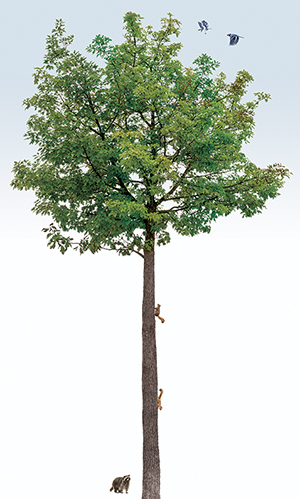Writing by Whit Beals
Have you ever found yourself struggling for traction on a dry slope while on a fall walk in a hardwood stand? The cause of that slipperiness might have been freshly fallen Northern Red Oak (Quercus rubra) leaves, which have waxy surfaces, or an abundance of the tree’s acorns, which in some years cover the forest floor with “nature’s marbles.” Both the acorns and the leaves tie to the oak’s evolutionary strategy.
Red oaks evolved in concert with the now extinct Passenger Pigeon. It is estimated that 2 to 5 billion of these plump birds once inhabited the eastern forests. Their primary fall food was red oak acorns, and they would descend on forests in the midst of heavy acorn crop years—called mast years—in such abundance they would break off oak branches, building kindling on the forest floor. Similarly, the waxy oak leaves are fire prone once dry. This adaptation, combined with the life history of the Passenger Pigeon, helped create conditions for surface fires that oaks can often resist, but that may kill competing species.
You can spot red oaks in spring, when beautiful pink leaves covered in silky down emerge from the trees’ buds. Keep an eye out for them as you explore the woods this season.
Leaves
Leaves have pointed lobes, and are five to ten inches long and four to six inches broad. In summer, leaves are a dark green, and they turn a rich red or brown in fall.
Bark
 Northern Red Oak’s distinct bark makes for an easy way to identify the tree species. Its bark appears to have irregular shiny stripes—they resemble downhill ski trails streaking a distant hill—between rougher ridges. A few other oaks have bark with this kind of appearance in the upper branches, but the Northern Red Oak is the only one with striping all the way down the trunk, except in trees of very large diameter when the bark becomes rougher at the base. Red oaks often hybridize with black and scarlet oaks, but the hybrids’ “ski trails” are apparent only in the upper branches.
Northern Red Oak’s distinct bark makes for an easy way to identify the tree species. Its bark appears to have irregular shiny stripes—they resemble downhill ski trails streaking a distant hill—between rougher ridges. A few other oaks have bark with this kind of appearance in the upper branches, but the Northern Red Oak is the only one with striping all the way down the trunk, except in trees of very large diameter when the bark becomes rougher at the base. Red oaks often hybridize with black and scarlet oaks, but the hybrids’ “ski trails” are apparent only in the upper branches.
Age and Size
In forests, these trees grow straight and tall to a height of about 100 feet, though exceptional trees will reach 140 feet. Their trunks reach up to 40 inches in diameter. When they grow in the open, red oaks don’t get as tall but they can develop stouter trunks, up to six feet in diameter. Trees may live up to 400 years according to the US Forest Service.
Wildlife Habitat
 While the acorns are bitter, at least to human taste buds, years with high acorn yield can be a great benefit to many acorn-eating species of birds and mammals, including jays, wild turkeys, grouse, mice, chipmunks, squirrels, raccoons, bears, and deer. The “boom and bust” cycles of small-mammal populations generally coincide with high and low acorn production.
While the acorns are bitter, at least to human taste buds, years with high acorn yield can be a great benefit to many acorn-eating species of birds and mammals, including jays, wild turkeys, grouse, mice, chipmunks, squirrels, raccoons, bears, and deer. The “boom and bust” cycles of small-mammal populations generally coincide with high and low acorn production.
Growing Conditions and Timber
Northern Red Oaks grow rapidly and are tolerant of a variety of soils and site conditions, though they prefer well-drained lower slopes and stream bottoms. A typical southern New England woodlot might have drier sites hosting black, scarlet, and white oaks, with red oaks growing at lower elevations where the soils are deeper and moister. Red oak also persists onto warmer, drier sites in some northern portions of the region.
The tree produces very durable timber that is commonly used in cabinetry, furniture, interior trim and flooring, and is a particularly popular flooring choice.
Red oak also is the most financially valuable timber on NEFF’s approximately 29,000 acres of Community Forests even though it comprises just 20 percent of the total sawlog volume. Red oak, although slightly less abundant than white pine on NEFF’s lands, sells for about three times the per-unit value of the pine. As a result, red oak forms about 36 percent ($11 million) of our total value of standing timber ($33 million).
